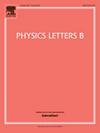A background for thermal photons in heavy ion collisions
IF 4.3
2区 物理与天体物理
Q1 ASTRONOMY & ASTROPHYSICS
引用次数: 0
Abstract
In this work, we present the transverse momentum spectra of prompt and decay photons in Au-Au collisions for 200 GeV, 62.4 GeV, 39 GeV, and 27 GeV. The major sources of the photons in Angantyr include hard processes, Parton showers, and resonance decay. The multiparton interactions and hadronic rescatterings significantly increase the photon yield. The model shows a good match with the available experimental data at high . The difference in yield at low suggests that Quark Gluon Plasma of = 0.167 GeV/c in central Au-Au collision at 200 GeV is formed, the new effective temperature is less than the ones extracted without removing background photons. At low the decay photon spectra scales with , the scaling is independent of collision energy and system size. The scaling no longer holds at high and the spectra become beam energy dependent. The scaled spectra of p-p and d-Au collisions show an opposite trend at high , their scaled yield is greater than the Au-Au collision at the same energy.
求助全文
约1分钟内获得全文
求助全文
来源期刊

Physics Letters B
物理-物理:综合
CiteScore
9.10
自引率
6.80%
发文量
647
审稿时长
3 months
期刊介绍:
Physics Letters B ensures the rapid publication of important new results in particle physics, nuclear physics and cosmology. Specialized editors are responsible for contributions in experimental nuclear physics, theoretical nuclear physics, experimental high-energy physics, theoretical high-energy physics, and astrophysics.
 求助内容:
求助内容: 应助结果提醒方式:
应助结果提醒方式:


